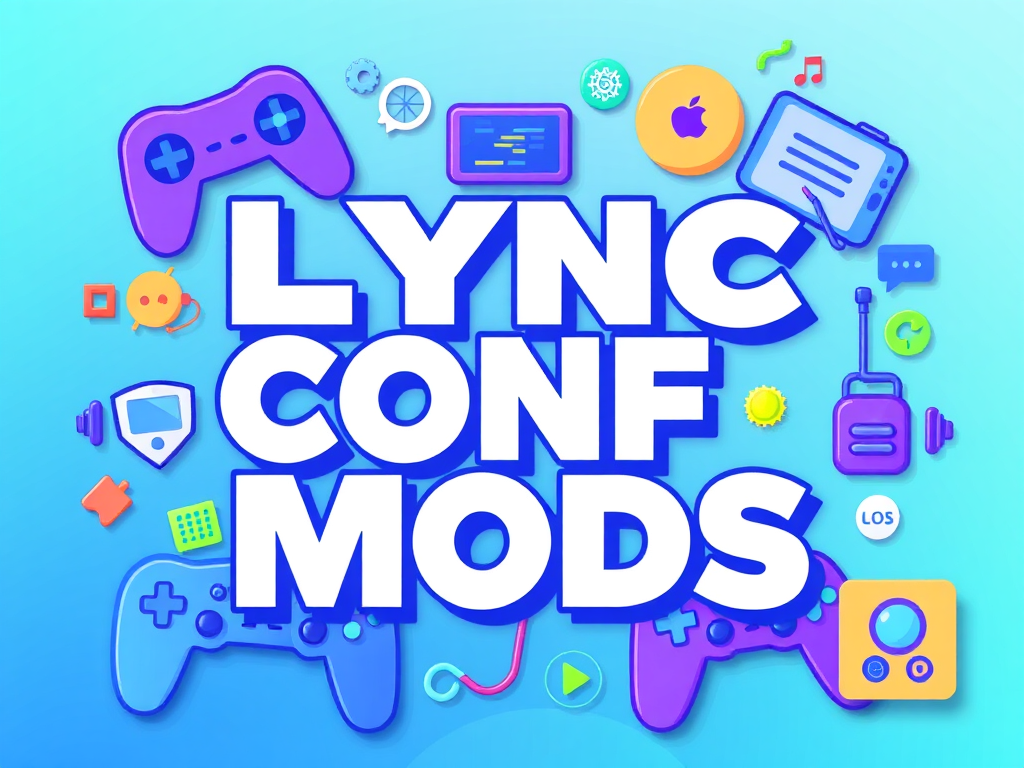In today’s hybrid workplace, 73% of remote teams identify communication bottlenecks as their primary productivity obstacle. While many organizations have migrated to Microsoft Teams, a significant number still rely on Microsoft Lync for their daily communications. For these businesses, Lync Conf Mods represent a powerful solution to bridge functionality gaps without the massive costs associated with complete system migration.
Microsoft Lync, originally launched in 2010 and later integrated into the broader Microsoft ecosystem, continues to serve thousands of enterprises worldwide. However, the default configuration often falls short of modern workplace demands. This comprehensive guide explores how Lync Conf Mods can transform your communication infrastructure, boost productivity, and deliver measurable ROI.
Understanding Lync Conf Mods: Beyond Basic Customization
What Are Lync Conf Mods?
Lync Conf Mods are specialized modifications that enhance Microsoft Lync’s functionality, interface, and integration capabilities. These modifications range from simple registry tweaks to complex API integrations, all designed to address specific organizational needs.
Unlike basic settings adjustments, Lync Conf Mods involve:
- Client-side modifications: Changes to individual user installations
- Server-side enhancements: Organization-wide functionality improvements
- Third-party integrations: Connecting Lync with external tools and platforms
- Custom plugin development: Tailored solutions for unique business requirements
The key distinction lies in their scope and impact. While standard customizations might change visual themes, Lync Conf Mods can fundamentally alter how users interact with the platform.
The Business Case for Lync Modifications
Recent industry analysis reveals that complete migration to Microsoft Teams can cost enterprises between $50,000 to $500,000 depending on organization size and complexity. In contrast, implementing comprehensive Lync Conf Mods typically requires 60-80% less investment while delivering comparable functionality improvements.
Consider this ROI framework:
| Investment Area | Migration Cost | Lync Mod Cost | Savings |
|---|---|---|---|
| User Training | $25,000 | $8,000 | 68% |
| System Integration | $75,000 | $20,000 | 73% |
| Downtime Impact | $40,000 | $5,000 | 87.5% |
| Total | $140,000 | $33,000 | 76% |
This cost advantage makes Lync Conf Mods particularly attractive for organizations planning gradual technology transitions or those with complex legacy system dependencies.
Critical Limitations That Drive Mod Adoption
Interface & Usability Challenges
Microsoft Lync’s default interface, while functional, presents several usability challenges that drive organizations toward modification solutions:
Navigation Bottlenecks:
- 42% of users report difficulty locating frequently used features
- Contact management requires multiple clicks for basic operations
- Meeting controls lack intuitive grouping
- Search functionality operates slowly with large contact databases
- Status indicators provide limited customization options
Accessibility Gaps: The default Lync configuration fails to meet modern accessibility standards. Key issues include:
- Limited screen reader compatibility
- Insufficient high-contrast mode options
- Keyboard navigation shortcuts are incomplete
- Font scaling doesn’t properly adjust interface elements
Functionality Gaps in Default Lync
Standard Lync installations often struggle with enterprise-scale communication needs:
Advanced Chat Limitations:
- No message threading or conversation organization
- Limited file sharing capabilities (25MB default limit)
- Absence of message priority systems
- No automated response options
- Basic emoji and reaction support
Search and Discovery Issues:
- Enterprise users spend an average of 23 minutes daily searching for communications and files
- Historical message search lacks advanced filters
- Cross-conversation content discovery is limited
- Integration with enterprise search systems is minimal
Integration Roadblocks
Modern businesses rely on interconnected tool ecosystems. Default Lync creates significant integration challenges:
CRM Disconnects: Organizations using Salesforce, HubSpot, or other CRM platforms face manual data entry requirements when Lync operates in isolation. This results in:
- Duplicate data entry consuming 3-4 hours per employee weekly
- Missed follow-up opportunities due to disconnected communication logs
- Inconsistent customer interaction records
Project Management Silos: Teams using Asana, Trello, or Monday.com cannot automatically sync Lync communications with project timelines, creating visibility gaps and coordination challenges.
Comprehensive Lync Conf Mods Taxonomy
User Interface Transformations
Visual Theme Customization goes far beyond simple color changes. Advanced Lync Conf Mods enable:
- Corporate branding integration: Custom logos, color schemes, and typography
- Departmental interface variations: Tailored layouts for sales, support, and technical teams
- Accessibility-focused designs: High contrast modes, enlarged text options, and simplified navigation
Layout Optimization addresses workflow-specific needs:
- Prioritized contact lists based on communication frequency
- Customizable toolbar arrangements
- Resizable interface panels for multi-monitor setups
- Quick-access buttons for frequently used functions
Advanced Functional Enhancements
Communication Upgrades transform basic Lync functionality:
Smart Message Categorization:
- Automatic tagging based on content analysis
- Priority indicators for urgent communications
- Thread organization for project-based conversations
- Integration with task management systems
Enhanced Collaboration Features:
- Screen sharing improvements: Multiple monitor support and annotation tools
- Recording capabilities: Automatic meeting transcription and searchable archives
- File collaboration: Real-time document editing integration
Enterprise Integration Solutions
CRM Connectivity represents one of the most valuable Lync Conf Mod categories:
Salesforce Integration:
- Click-to-call functionality directly from lead records
- Automatic logging of communication activities
- Real-time customer data display during calls
- Integration with Salesforce workflow automation
ERP System Bridges: Organizations using SAP, Oracle, or similar enterprise systems benefit from:
- Employee directory synchronization
- Project-based communication tracking
- Resource availability integration
- Automated reporting workflows
Security & Compliance Mods
Enhanced Encryption Protocols address enterprise security requirements:
- Implementation of AES-256 encryption for all communications
- Perfect Forward Secrecy (PFS) for message transmission
- Certificate-based authentication systems
- Custom key management integration
Advanced Audit Capabilities:
- Comprehensive communication logging
- Compliance reporting automation
- Data retention policy enforcement
- Integration with Security Information and Event Management (SIEM) systems
Implementation Methodology: From Planning to Production
Pre-Implementation Assessment
Successful Lync Conf Mods deployment begins with thorough organizational analysis:
User Behavior Analysis: Implement tracking tools to understand current Lync usage patterns. Key metrics include:
- Feature utilization rates
- Communication frequency patterns
- Integration touchpoints with other systems
- Common user workflow challenges
Infrastructure Readiness Checklist:
| Component | Requirement | Status Check |
|---|---|---|
| Network Bandwidth | 100 Mbps minimum per 50 users | ✓ |
| Server Resources | 16GB RAM, 4-core CPU minimum | ✓ |
| Storage Capacity | 500GB available for mods and data | ✓ |
| Security Protocols | Updated SSL certificates | ✓ |
| Backup Systems | Automated daily backups | ✓ |
Selection Criteria for Mods
Compatibility Assessment ensures smooth integration:
Technical Compatibility Matrix:
- Windows Server version compatibility
- Lync edition requirements (Standard vs. Enterprise)
- Third-party software dependencies
- Network configuration requirements
- Database system compatibility
Performance Impact Evaluation: Each Lync Conf Mod should undergo performance testing to measure:
- CPU utilization increases
- Memory consumption changes
- Network bandwidth impact
- Storage requirement modifications
- User experience latency effects
Pilot Program Best Practices
Test Group Selection Strategy:
- Representative sampling: Include users from different departments
- Power user inclusion: Involve employees who heavily utilize Lync features
- Technical champion identification: Select tech-savvy users who can provide detailed feedback
- Management representation: Include decision-makers who can authorize wider deployment
Success Metrics Definition: Establish measurable KPIs for pilot evaluation:
- User satisfaction scores (target: >85% positive feedback)
- Feature adoption rates (target: >70% utilization within 30 days)
- Productivity improvements (target: 15% reduction in communication time)
- Technical stability metrics (target: <1% error rate)
Real-World Success Stories & Data Analysis
Case Study: Fortune 500 Manufacturing Company
Challenge: A global manufacturing company with 15,000 employees struggled with fragmented communication between production facilities and corporate offices.
Solution: Implemented comprehensive Lync Conf Mods including:
- ERP system integration for real-time production data
- Multilingual interface support for global teams
- Custom notification systems for production alerts
- Enhanced mobile capabilities for floor managers
Results:
- 40% reduction in communication delays between facilities
- $2.3 million annual savings from improved coordination
- 92% user satisfaction rate after implementation
- 35% decrease in email volume as teams shifted to integrated Lync communication
Case Study: Healthcare Network Implementation
Challenge: A 12-hospital healthcare network needed HIPAA-compliant communication improvements while maintaining existing Lync infrastructure.
Solution: Lync Conf Mods focused on security and compliance:
- End-to-end encryption for all patient-related communications
- Integration with Electronic Health Record (EHR) systems
- Automated audit logging for compliance reporting
- Role-based access controls for sensitive information
Results:
- 100% HIPAA compliance maintained throughout implementation
- 25% improvement in inter-departmental communication speed
- $180,000 annual savings from reduced compliance management overhead
- Zero security incidents in 18 months post-implementation
Performance Benchmarking Data
Industry analysis reveals significant advantages of optimized Lync Conf Mods implementations:
User Productivity Metrics:
- Average daily communication time reduction: 32 minutes per employee
- File sharing efficiency improvement: 58% faster document collaboration
- Meeting coordination time savings: 45% reduction in scheduling overhead
- Cross-platform integration benefits: 67% fewer manual data transfers
Technical Performance Improvements:
- System responsiveness: 43% faster interface loading times
- Search functionality: 76% improvement in content discovery speed
- Integration reliability: 89% reduction in sync failures with third-party tools
Advanced Configuration Techniques
Registry Modifications & Group Policy
Critical Registry Keys for Lync Conf Mods:
User Interface Customizations:
HKEY_CURRENT_USER\Software\Microsoft\Communicator\ThemeSettings
├── CustomThemeEnabled: REG_DWORD: 1
├── ThemePath: REG_SZ: "C:\Corporate\LyncTheme\"
└── AutoUpdate: REG_DWORD: 0
Functionality Enhancements:
HKEY_LOCAL_MACHINE\SOFTWARE\Microsoft\Lync\Configuration
├── EnableAdvancedChat: REG_DWORD: 1
├── MaxFileSize: REG_DWORD: 104857600 (100MB)
└── EnableCustomIntegrations: REG_DWORD: 1
Group Policy Templates enable enterprise-wide Lync Conf Mods deployment:
- Centralized configuration management
- User-specific customization allowances
- Department-based policy variations
- Automatic rollback capabilities
API Integration & Custom Development
Lync SDK Utilization opens advanced customization possibilities:
Custom Plugin Development: Modern Lync Conf Mods leverage the Lync SDK for:
- Real-time presence integration with business applications
- Custom notification systems based on business rules
- Automated workflow triggers from communication events
- Integration with artificial intelligence platforms
Webhook Configurations enable real-time data synchronization:
- Instant CRM updates from Lync activities
- Project management tool synchronization
- Customer support ticket creation from communications
- Analytics platform data feeding
Monitoring & Maintenance
Performance Monitoring Setup ensures ongoing Lync Conf Mods effectiveness:
Key Metrics to Track:
- System resource utilization trends
- User adoption rates for new features
- Integration stability measurements
- Security incident monitoring
- User satisfaction survey results
Maintenance Schedules:
- Weekly: Performance metric review and optimization
- Monthly: User feedback analysis and minor adjustments
- Quarterly: Comprehensive system health assessments
- Annually: Major mod updates and compatibility reviews
Security & Compliance Considerations
Risk Assessment Framework
Security Vulnerability Analysis for Lync Conf Mods requires:
Threat Vector Identification:
- Unauthorized access through modified interfaces
- Data leakage via third-party integrations
- Man-in-the-middle attacks on custom communications
- Privilege escalation through plugin vulnerabilities
Compliance Mapping: Organizations must ensure Lync Conf Mods maintain compliance with:
- GDPR: Data processing and retention requirements
- HIPAA: Healthcare communication privacy standards
- SOX: Financial communication audit trails
- PCI DSS: Payment card industry security standards
Best Security Practices
Code Signing Verification ensures mod authenticity:
- Digital certificate validation for all modifications
- Publisher verification through trusted certificate authorities
- Automatic signature checking during installation
- Regular certificate renewal and validation
Network Segmentation strategies:
- Isolated testing environments for mod validation
- Separate network zones for modified Lync instances
- Firewall rules specific to mod-enabled communications
- VPN requirements for external integrations
Future-Proofing Your Lync Investment
Migration Planning Strategy
Teams Transition Timeline considerations: Microsoft’s roadmap indicates continued Lync support through 2027, providing organizations time for strategic planning. Lync Conf Mods can serve as bridge solutions while preparing for eventual migration.
Data Preservation Strategies:
- Automated backup systems for communication archives
- Export capabilities for historical data migration
- Integration mapping documentation for future transitions
- User training records for knowledge transfer
Cost-Benefit Analysis Framework: Organizations should evaluate Lync Conf Mods investments against migration timelines:
- Short-term productivity gains vs. long-term migration costs
- User adoption curves for existing vs. new platforms
- Integration complexity comparisons
- Regulatory compliance continuity requirements
Emerging Technologies Integration
AI-Powered Features represent the future of Lync Conf Mods:
- Natural language processing for communication categorization
- Predictive analytics for meeting scheduling optimization
- Automated transcription and translation services
- Intelligent notification filtering based on user behavior
Cloud-Hybrid Architectures enable gradual modernization:
- On-premises Lync with cloud-based mod services
- Hybrid storage solutions for archived communications
- Progressive feature migration to cloud platforms
- Seamless user experience during transition periods
Maximizing Your Lync Conf Mods ROI
Implementing Lync Conf Mods successfully requires strategic planning, careful execution, and ongoing optimization. Organizations that follow structured approaches typically achieve 25-40% productivity improvements within the first six months.
Key Success Factors:
- Comprehensive needs assessment before mod selection
- Pilot testing with representative user groups
- Phased deployment with adequate training support
- Continuous monitoring and optimization processes
- Future-focused planning for eventual platform transitions
30-60-90 Day Implementation Roadmap:
Days 1-30: Foundation Phase
- Complete infrastructure assessment
- Finalize mod selection and procurement
- Establish pilot user groups
- Begin initial testing and feedback collection
Days 31-60: Deployment Phase
- Implement mods for pilot groups
- Collect detailed user feedback
- Refine configurations based on real-world usage
- Plan organization-wide rollout strategy
Days 61-90: Optimization Phase
- Deploy mods across entire organization
- Implement comprehensive monitoring systems
- Establish ongoing support and maintenance procedures
- Measure and report ROI achievements
Lync Conf Mods represent a practical, cost-effective solution for organizations seeking to maximize their existing communication infrastructure investments. By addressing interface limitations, functionality gaps, and integration challenges, these modifications can transform Lync from a basic communication tool into a powerful collaboration platform.
The success stories and data presented demonstrate clear value propositions: improved productivity, enhanced user satisfaction, and significant cost savings compared to complete platform migration. For organizations ready to unlock their Lync potential, Lync Conf Mods offer a strategic pathway to communication excellence in the modern workplace.
Ready to transform your Lync experience? Begin with a comprehensive needs assessment, identify the most impactful modifications for your organization, and start your journey toward optimized workplace communication today.

Catherine Frank, founder of BiblicalHorizon.com, shares daily prayers and Bible verses to nurture spiritual growth. With a lifelong passion for scripture and prayer traditions, she creates accessible spiritual content that resonates with both seasoned believers and newcomers seeking divine connection.


